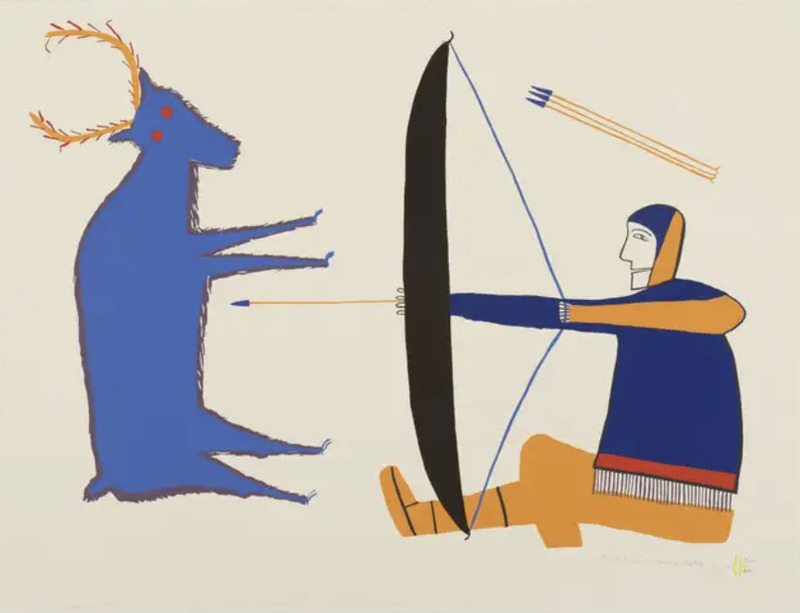Hunting and Gathering
Western Perspective
For many decades, explorers have ventured to the Arctic and captured what they see. However, over time, the object behind the camera has changed.
"If a person or anything man-made, such as a house, got in a photo by mistake, I would discard them. Today, it's different."
--Carsten Estevang
As Egevand has said, he overtime shifted his photography from climate change and animals to understanding the native culture and the people in it. The object behind the camera is not ice and landscape but rather gaining perspective to native culture and lifestyle. Here are examples of a western perespective on Arctic hunting and gathering from western artists other than Egevand.
Here, in the two images shown, artists have captured hunting and gathering in the Arctic. Notice that both of these images lack significant color and have unidentified individuals. The western perspective here is able to capture the native lifestyle, yet there is not specific information about either image--the images remain ambiguous. The men and women remain unidentified, and the specific tools and locations also remain unknown. We also do not understand the importance of hunting and gathering to the native culture or community.
The image titled Equipment; Hunting; Individuals: male, Inuit depicts three Inuit men holding hunting tools. One of the tools being held appears to be a spear. However, we do not know who the individuals are, noticing specifically how it is hard to make out their faces. We can also notice that the men are wearing many layers of clothing, and specifically, fur can be seen on one of the men. So, we can make the assumption that the temperature is very cold, which makes sense since the description of this image indicates that this is a Canadian Arctic Expedition. Additionally, we can see that there is grass on the ground, so the three men are hunting on grass covered ground rather than ice. The image does not detail the importance of hunting in indigenous culture nor describe the details of any of the tools used for hunting. This image also lacks animals. Lastly, the title of the image is just a description of exactly what we see and nothing more. Thus, it becomes the observers' responsibility to identify what is occuring in the image. The western perespective does not provide descriptive details here.
The image titled A fishing camp--sun drying the fish is again a very objective title of the image. Different from the other image shown, there are eleven total men, women and children. Some of the older individuals have younger children on their shoulders. Further, all of the individuals appear to be in heavy clothing, which is again indicative of the cold temperatures. Additionally, it is hard to make out the faces of the individuals, keeping their identities unknown. Some of the individuals are grouped together whereas others are sitting alone. In addition to native individuals, there are some dogs that are depicted in the image. Next, it appears that fish have been hunted and are now being dried out, but we cannot tell what type of fish these are. There are a lot of fish, which appear to be food for the entire community. There are also tents which depict a civilization of some sort. There are some wooden looking stakes put together in triangular formations, which may be indicative of the beginning stages for making more tents. This image does not show the importance of the fish that has been hunted in my perespective since there is no detail of the animal. Thus, the western perspective takes away the importance of the relationship between the native hunters and the hunted animals.
Inuit culture of hunting and gathering is being captured through a western lens. However, there is not much specificity to what is taking place. Additionally, there is no understanding of the importance of the relationship between the native hunters and animals. Further, these images appear to make the civilizations look very primitive. The western artist is capturing what they see without truly understanding what they are seeing. So, the responsibility for interpretation of the images rests in the hands of the viewer.
Indigenous Perespective
The first thing that strikes me when looking at these pieces is the representation of women in indigenous hunting practices. In the statue A woman carrying a butchered animal, a woman is represented as the one who has hunted and provided for her people. The sculpture, carved in soapstone, depicts a woman carrying an animal appearing to be a muskox or other animal with horns. She is carrying it carefully, and seems intent on moving forward with the animal. What also strikes me is the detail depicted on her clothing. The animal itself is not very detailed, but the woman’s clothing demonstrates the care that is taken in making the gear and clothing that is worn on the hunt. The clothing worn is perhaps as important as the hunt itself in the harsh conditions of the Arctic.
According to an exhibit at the Mariner’s Museum (2021), in many Inuit-Yupik groups it is not just about a man’s skill in hunting that leads to a successful hunt, it is actually about the woman’s spiritual connection to the animals being hunted. This is because she is the one who sews the clothing, made of animal skins, for the hunt, and takes extensive care in cutting the animal’s skin and using it for an important purpose. It is this that gives her a unique connection to the animal. For example, while not pictured in this exhibit, the Mariner’s Museum shows a delicately carved walrus tusk of a man hunting a bowhead whale. This tusk was used as an Inuit marriage proposal, and features a woman watching over her beloved as he hunts, but even though it is the man about to spear the whale, it is the woman who has total control. It is through all of her combined skills; sewing, hunting, and more, that she draws the whale to the team, as her spirit is connected to the whale’s spirit. Further, Alaskan Iñupiaq women, and most particularly wives, are considered pivotal to successful hunting because wives ritually attract the animals and are thus classed as hunters by Iñupiaq men (Bodenhorn 1990).
The second image chosen, The Great Hunter, shows an ambiguously gendered person hunting a horned animal. The animal is quite close to the hunter, again emphasizing the connection Indigenous hunters have with the animals that they hunt. The hunter has three extra arrows, but it is unlikely that they will be needed, due to how close they are to the animal. Perhaps this is why this hunter is called “The Great Hunter:” because of the strong connection the hunter shares with the animal. There is also a great emphasis on the clothing that the hunter wears, emphasizing again the importance of gear and dress in Indigenous hunting practices.
Together, these works represent two main ideas shown by Indigenous perspectives on hunting: the importance of dress, and thus the importance of the connection with the animal that is being hunted.
Sources Cited:
Barbara Bodenhorn, "'I'm Not the Great Hunter, My Wife Is': Iñupiat and anthropological models of gender," Études Inuit Studies 14, no. 1/2 (1990): 55-74, https://www.jstor.org/stable/42869683.
Jennifer Hackney, "Women's Magic of the Arctic," Mariner's Museum (2021), https://www.marinersmuseum.org/2021/03/womens-magic-of-the-arctic/.
Kirstine Biltoft-Knudsen. “Capturing Arctic Change through Photography.” Arctic, April 6, 2018. https://deeply.thenewhumanitarian.org/arctic/articles/2016/11/15/capturing-arctic-change-through-photography.




